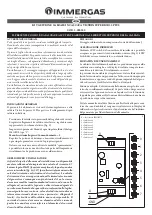
BLUEHELIX TECH RRT 24 C
20
EN
cod. 3541P250 - Rev. 01 - 07/2018
Condensate drain
(Please follow BS 6798 or Industry Guidance for Installers on Condensate pipe Installation)
The condensate should be run inside as far as is practicably possible. For that purpose, use a pipe of at least 22 mm
diameter and a trap with flexible connection supplied with the unit to facilitate connection of the condensate drain pipe.
The pipe must be in solvent weld plastic and not in copper, since the condensate has a pH of 4 (slightly acid).
If the condensate drain pipe cannot be run on the inside, then it is advisable to run it outside & into a gully connected to
a sewer system.
The pipe sections going to the outside are exposed to the risk of freezing in particularly extreme weather conditions. To
prevent this from occurring, it is advisable to reduce the length of the condensate drain pipes and run them on the inside,
as much as possible, before going to the outside. It is mandatory to insulate the condensate pipe or apply a trace heat-
ing device to help prevent freezing of the condensate.
The pipes outside the building must be in solvent weld plastic with increased diameter of 40 mm covered with "Class 0"
pipe insulation with a maximum length of 3m & connected to a condensate collection soakaway or external drain.
If using a condensate collection soakaway, it must be as indicated in the figure below, or use a specific system (such
as Mc Alpine SOAK1GR) available from the majority of plumbing and heating suppliers.
fig. 30 - Condensate drain
External
40mm Class 0 Insulated Solvent weld pipework (Max mtrs)
Cement seal
100mm Dia tube
Bottom sealed
Lime stone chippings
Ground level (either/Or)
Hole depth 400mm
25mm
2 Rows of
3x12 mm Holes
Internal
-300mm
2.5° Minimum fall
















































